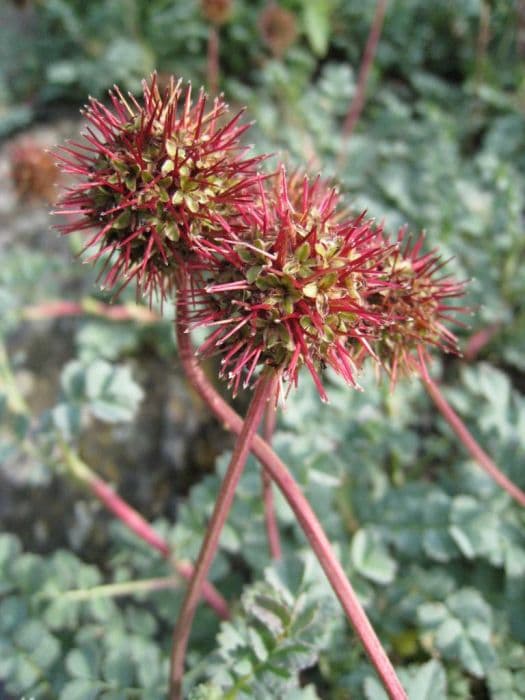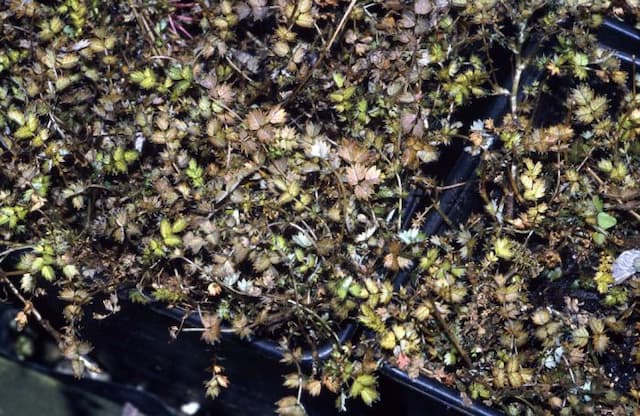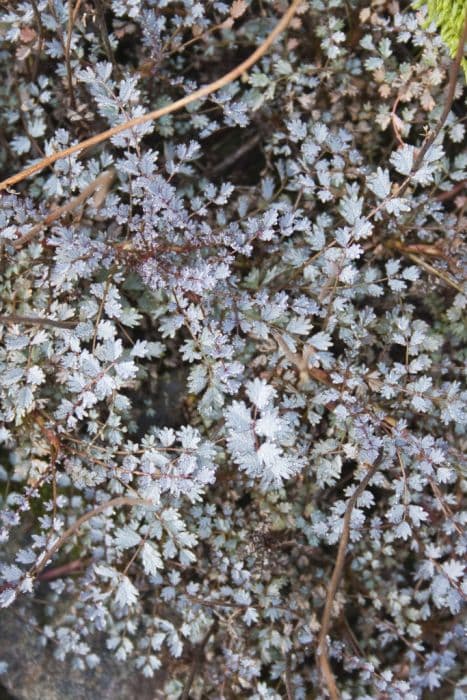Elstar Apple Malus domestica 'Elstar' (D)

ABOUT
The 'Elstar' apple tree, as it's commonly known, is a variety featuring a spreading canopy filled with ovate-shaped leaves that possess a rich green hue. The leaves are slightly serrated along the edges and have a somewhat glossy texture that catches the light. During the blooming season, the tree is adorned with an enchanting display of flowers, which are usually white with a subtle shade of pink. Upon pollination, these flowers gradually give way to fruit – the main attraction of the 'Elstar' apple tree. The apples themselves are medium-sized and boast an attractive combination of red and yellow. They tend to have a flush of red striping or mottling overlaid on the yellow background, which can vary in intensity depending on sun exposure and other growing conditions. The skin of the fruit is smooth but can have some texture with lenticels visible. As for the flavor, the apples are known for their delightful balance of sweet and acidic, making them a popular choice for both fresh eating and culinary uses. The flesh inside is crisp and juicy, providing a satisfying bite and refreshing taste.
About this plant
 Names
NamesFamily
Rosaceae
Synonyms
Elstar Apple
Common names
Malus domestica 'Elstar'
 Toxicity
ToxicityTo humans
The plant in question is an apple variety, and apples are not toxic to humans when eaten as the fruit we commonly consume. However, the seeds of the apple can contain compounds that can produce cyanide when digested. Ingesting a large quantity of apple seeds can potentially lead to symptoms of cyanide poisoning, which may include headache, confusion, agitation, difficulty breathing, and can be potentially life-threatening if consumed in very large quantities. It is generally advised not to consume the seeds, but the flesh of the apple fruit itself is safe and nutritious to eat.
To pets
The apple variety, commonly known simply as an apple, is not typically toxic to pets, especially when offered in moderation as the flesh of the fruit. Similar to humans, the seeds can be harmful if ingested in large amounts due to the possibility of cyanide release upon digestion. Symptoms of cyanide poisoning in pets might include panting, difficulty breathing, dilated pupils, and shock, which could be life-threatening. However, pets would need to consume a very large quantity of seeds for this to be a concern. It is always best to remove the seeds and core before offering apples to pets.
 Characteristics
CharacteristicsLife cycle
Perennials
Foliage type
Deciduous
Color of leaves
Green
Flower color
White
Height
12-15 feet (3.7-4.6 meters)
Spread
12-15 feet (3.7-4.6 meters)
Plant type
Tree
Hardiness zones
5-7
Native area
Asia
Benefits
 General Benefits
General Benefits- Delicious Fruits: Elstar apples are known for their sweet and slightly tart flavor, which makes them a popular choice for eating fresh or using in cooking and baking.
- Nutritional Value: The apples are a good source of dietary fiber, vitamin C, and various antioxidants, contributing to a balanced diet.
- Aesthetic Appeal: The Elstar apple tree offers ornamental value with its blossoms in spring and attractive fruit in the fall, enhancing garden landscapes.
- Pollinator-Friendly: The flowers of the Elstar apple tree attract bees and other pollinators, supporting biodiversity in the garden ecosystem.
- Economic Value: As a commercially cultivated apple variety, Elstar apples contribute to local and global economies through the fruit production industry.
- Culinary Versatility: Elstar apples can be used in a variety of culinary applications, from raw snacks to cooked dishes, juices, and desserts.
 Medical Properties
Medical Properties- Antioxidant content: Apples, such as the Elstar variety, are rich in antioxidants, which can help protect cells from damage and may reduce the risk of chronic diseases.
- Dietary fiber: The high fiber content in apples is beneficial for digestive health and can aid in regulating bowel movements.
- Vitamin C: Elstar apples contain vitamin C, which is important for immune system function, skin health, and wound healing.
- Polyphenols: Apples contain polyphenols, which may have anti-inflammatory effects and contribute to heart health.
- Quercetin: This flavonoid found in apples has potential anti-inflammatory and antihistamine effects, which may be beneficial for allergies and respiratory health.
 Air-purifying Qualities
Air-purifying QualitiesThis plant is not specifically known for air purifying qualities.
 Other Uses
Other Uses- Decorative Arrangements: Branches of the apple tree can be used in decorative arrangements or as part of wreaths due to their sturdy nature and the aesthetic appeal of their leaves and fruit.
- Natural Dyes: The leaves and bark of the apple tree can be boiled to extract natural dyes for fabric or crafts, yielding a range of tans, browns, or yellows depending on the mordant used.
- Woodworking Projects: Apple wood, known for its fine grain and strength, can be used in woodworking for creating small furniture pieces, turned bowls or decorative objects.
- Fruit Pectin: The naturally occurring pectin in Elstar apples can be extracted and used as a gelling agent for making homemade jellies and jams.
- Educational Tools: The apple tree and its growth cycle can be used as a teaching tool for educational purposes, explaining plant biology, pollination, and fruit development to students.
- Photography Practice: The diverse stages of apple tree growth and its fruits provide excellent subjects for photography, helping photographers to practice their skills.
- Fruit Carving: The apples from the Elstar tree can be used for fruit carving, creating decorative plates and table centerpieces.
- Composting Material: Fallen leaves and rotten apples are good composting materials, enriching garden soil with organic matter.
- Natural Insect Repellant: Using pieces of apple wood or leaves in a fire could help repel insects due to the smoke produced, which can be uncomfortable for certain insects.
- Bird Feeding Station: Hanging apple halves on trees or bird feeders can act as a winter food source for wildlife, specifically birds.
Interesting Facts
 Feng Shui
Feng ShuiThe plant Apple Tree is not used in Feng Shui practice.
 Zodiac Sign Compitability
Zodiac Sign CompitabilityThe Apple Tree is not used in astrology practice.
 Plant Symbolism
Plant Symbolism- Love and Temptation: As an apple variety, Elstar apples are often associated with love and temptation, dating back to ancient mythologies where apples were considered forbidden fruits offering knowledge and sensual experience.
- Peace and Harmony: Gifting apples, including the Elstar variety, is sometimes a symbol of peace and a wish for harmony, possibly stemming from various cultural traditions around the world.
- Health and Vitality: Apples like the Elstar are synonymous with health and vitality, echoed in the phrase "an apple a day keeps the doctor away," representing a desire for wellness.
- Youthfulness and Beauty: The apple is also a symbol for beauty and youthfulness, given its frequent representation in art and mythology as a fruit that grants these characteristics.
- Knowledge and Education: With its ties to scholarly achievement and the pursuit of education, the apple, including the Elstar variant, can symbolize a commitment to learning and wisdom.
 Water
WaterElstar apples need consistent moisture, especially during the growing and fruiting seasons. Water young trees weekly with about 5 to 10 gallons, depending on weather conditions, ensuring moisture reaches the root zone. Mature trees typically require 15 to 20 gallons every week during dry periods. During rainy seasons, reduce watering accordingly. Overwatering can lead to root rot, so ensure the soil drains well and adjust watering based on rainfall.
 Light
LightElstar apples require full sun, which means they need at least six hours of direct sunlight daily. Plant them in a location without shade from buildings or taller trees to maximize their exposure to sunlight. The best spot is on a south-facing slope for optimal light and air circulation, which helps prevent diseases.
 Temperature
TemperatureElstar apples thrive in a range of temperatures but prefer moderate climates. They can survive winter lows down to about -20°F and summer highs up to 90°F, though ideal growing temperatures are between 60°F and 75°F. Providing a location with good airflow helps the tree handle temperature extremes.
 Pruning
PruningElstar apple trees should be pruned to maintain health, shape, and to encourage fruit production. Prune during the dormant season, typically late winter before new growth starts, removing dead or crossing branches and thinning the canopy for better air and light penetration. Depending on the tree's vigor, annual or biennial pruning may be necessary.
 Cleaning
CleaningAs needed
 Soil
SoilApple trees such as 'Elstar' thrive in well-draining loam or sandy loam soils with a pH between 6.0 and 7.0. A good soil mix can be made with two parts garden soil, one part peat moss, and one part aged compost to provide nutrients and proper drainage.
 Repotting
RepottingApple trees, like the 'Elstar' variety, typically do not require frequent repotting as they are often planted directly in the ground. If grown in pots, young trees might need repotting every 2-3 years until they are planted out or reach a manageable pot size for their location.
 Humidity & Misting
Humidity & MistingApple trees, such as the 'Elstar' variety, prefer outdoor conditions with average humidity levels. They can tolerate a range of humidity levels as long as the soil moisture and watering are well-managed.
 Suitable locations
Suitable locationsIndoor
Apple trees like 'Elstar' are not suited for indoor cultivation due to their size.
Outdoor
Plant 'Elstar' apple trees in sunny, well-draining soil with spacing for growth.
Hardiness zone
5-8 USDA
 Life cycle
Life cycleThe Elstar apple tree (Malus domestica 'Elstar') begins its life cycle as a seed, which after stratification, germinates to give rise to a seedling. The seedling stage involves the development of the plant's root system, stem, and first leaves. As it matures into a young tree, it undergoes vegetative growth, forming a stronger trunk, branches, and more leaves. This tree then enters the reproductive stage, blossoming annually in spring with white to pink flowers that, following pollination, set fruit in the form of apples. These apples mature over several months, typically ripening in late summer to mid-autumn, and once they are harvested, the plant enters a period of dormancy during the winter months. With adequate care, pruning, and maintenance, the Elstar apple tree can cycle through blossoming and fruiting for many years.
 Propogation
PropogationPropogation time
Late winter
Malus domestica 'Elstar', commonly known as the Elstar apple, is typically propagated by grafting, which is the most popular method for this cultivar. Grafting is done during the dormant season, usually late winter to early spring, before the sap starts flowing and the trees begin to leaf out. In this process, a scion, which is a short length of stem with two or more buds, is taken from the desired Elstar apple variety. The scion is then spliced onto a rootstock, which provides the root system for the grafted tree. The graft union is carefully wrapped to ensure it stays secure and protected from the elements as it heals. Over time, the two pieces will fuse together, and the scion will grow to produce the fruit characteristic of the Elstar apple, while the rootstock will determine the overall size and vigor of the tree.









